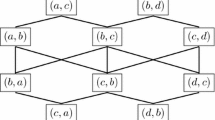Abstract.
The No Show Paradox (there is a voter who would rather not vote) is known to affect every Condorcet voting function. This paper analyses two strong versions of this paradox in the context of Condorcet voting correspondences. The first says that there is a voter whose favorite candidate loses the election if she votes honestly, but gets elected if she abstains. The second says that there is a voter whose least preferred candidate gets elected if she votes honestly, but loses the election if she abstains. All Condorcet correspondences satisfying some weak domination properties are shown to be affected by these strong forms of the paradox. On the other hand, with the exception of the Simpson-Cramer Minmax and the Young rule, all the Condorcet correspondences that (to the best of our knowledge) are proposed in the literature suffer from these two paradoxes.
Similar content being viewed by others
Author information
Authors and Affiliations
Additional information
Received: 30 November 1999/Accepted: 27 March 2000
Rights and permissions
About this article
Cite this article
Pérez, J. The Strong No Show Paradoxes are a common flaw in Condorcet voting correspondences. Soc Choice Welfare 18, 601–616 (2001). https://doi.org/10.1007/s003550000079
Issue Date:
DOI: https://doi.org/10.1007/s003550000079



